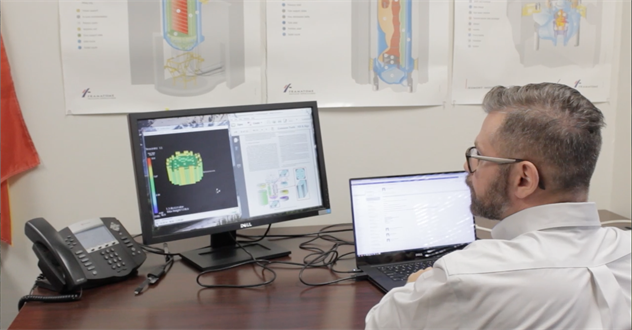
A research team with the Department of Nuclear Engineering at Texas A&M University, in collaboration with the South Texas Project Nuclear Operating Company (STPNOC), has solved Generic Safety Issue (GSI) - 191, a problem resulting from a loss of coolant accident in a nuclear reactor, which can cause debris to be generated and potentially impact the performance of the safety system.
 The team provided a solution to the U.S. Nuclear Regulatory Commission (NRC) for GSI-191 regarding the generation of debris during a loss of coolant accident and the potential consequences to the emergency system performance. The methodology that the team has developed will allow this safety issue to be addressed in light water reactors (LWR) across the country and is the first to be approved by the NRC.
The team provided a solution to the U.S. Nuclear Regulatory Commission (NRC) for GSI-191 regarding the generation of debris during a loss of coolant accident and the potential consequences to the emergency system performance. The methodology that the team has developed will allow this safety issue to be addressed in light water reactors (LWR) across the country and is the first to be approved by the NRC.
The loss of coolant accident is a design basis accident, meaning that when a reactor design is licensed, it has to be designed to handle these type of accidents safely under any circumstance. GSI-191 is a safety issue that results during a loss of coolant accident where debris can be generated and potentially impact the performance of the safety system pumping water through the primary system in an attempt to cool the reactor to safe levels. The debris blocking sump strainers and other flow paths can cause insufficient amounts of water to be recycled through the system, which means the reactor isn’t being cooled efficiently or safely.
To solve this problem, STPNOC partnered with Texas A&M to develop a widely applicable methodology, approved by the NRC, that can be applied to theoretically any operating LWR plant across the country. The methodology provides guidance on evaluating the safety level of the plant against the GSI-191, accounting for similarities and variable differences between plants.
“Our contribution became very important as we had to make sure the calculations we were doing were in compliance with NRC guidelines and expectations for thermal hydraulic calculations regarding licensing,” said Rodolfo Vaghetto, co-principal investigator with the project and a research assistant professor at Texas A&M.
Texas A&M’s collaboration with STPNOC on this project began in 2010, where through seven years of partnership and continuous interactions between five divisions and 14 branches of the NRC staff, the methodology was developed. In developing this methodology, two risk-informed approaches were used, the full risk-informed approach and the risk over deterministic method.

The department’s main attribution to this project is through the thermal hydraulics calculations and experimental studies performed. Texas A&M is the first to perform these types of complex analyses, with over 100 different scenarios simulated.
“The methodology is generic, so any power plants can adopt it while accounting for plant-specific parameters, Vaghetto said.”
Through the approval process of the licensing amendment, more than 50 public meetings and 400 requests of additional information were completed, in addition to 13 project audits, before the license amendment was issued in July 2017.
“We’ve made great progress in the nuclear power plant safety methodology and we look forward to other nuclear plants adopting the STPNOC methodology to resolve the GSI-191 issue,” Vaghetto said.
Students involved in the project felt that it gave them invaluable experience.
“The opportunity to work on GSI-191 let me solve a real industry problem,” said Tim Crook, a nuclear engineer at Transatomic Power and former student researcher with the project. “This breadth of exposure was invaluable towards my education experience and career choices. I’m proud to know that I made an impact on closing a 20-plus-year-old issue and simultaneously proved the robust safety case of nuclear power plants.”
The Texas A&M effort in this project involved the following researchers; Rodolfo Vaghetto, Alessandro Vanni, Yassin Hassan, Shin Kang, Angelo Frisani, Brad Beeny and Timothy Crook, in addition to more than 15 undergraduate students.